How to Catch Tautog: Complete Guide to Techniques, Gear, and Locations
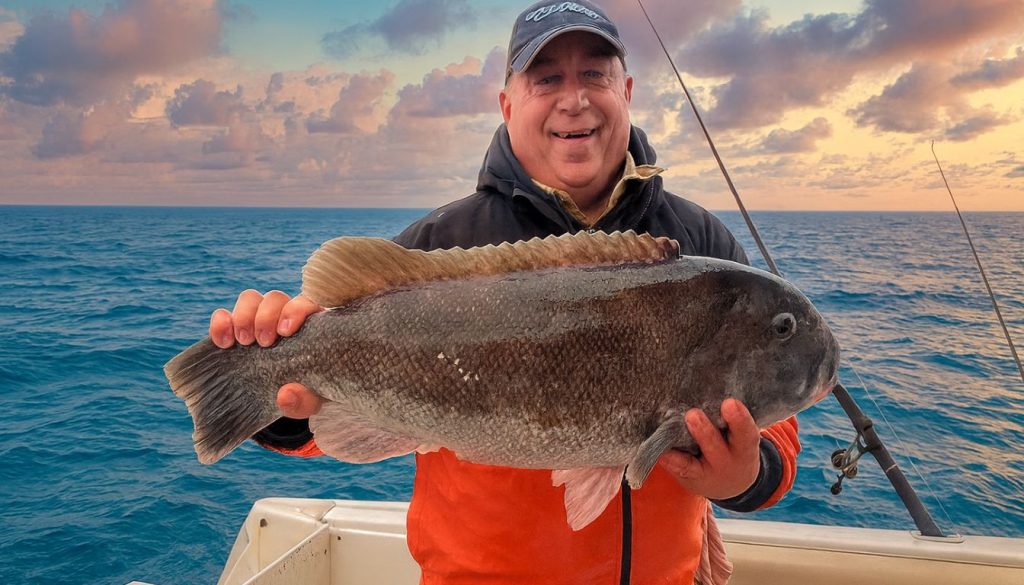
Species Profile
Quick Identification
The tautog (Tautoga onitis), commonly called blackfish, is a stocky wrasse found along the U.S. Atlantic coast (Nova Scotia to South Carolina). It has an olive-brown body with irregular white or pale blotches, a large blunt head, thick rubbery lips and powerful jaw teeth for crushing prey.
Tautog typically weigh about 1–3 lb (0.5–1.5 kg) and reach up to ~3 ft/90 cm long. World-record specimens approach 28–29 lb (13 kg). (For example, one fishing record tautog was 28 lb 13 oz.)
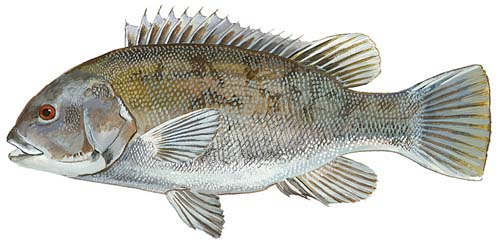
Why Target This Species
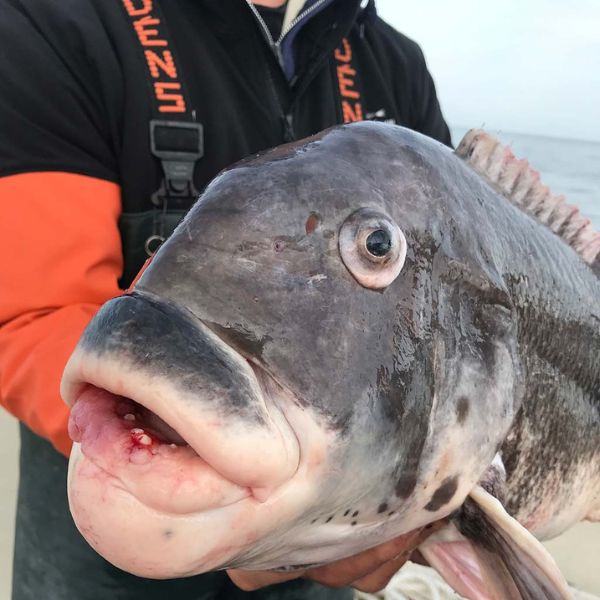
Catch difficulty: Tautog are tricky bottom fish – they hug rocks and structure and often taste-test baits before biting, making hook-ups challenging. Anglers generally rate tautog fishing as intermediate to advanced.
Sport value: They put up a strong fight, pulling hard on drag and racing into cover. “I’ve even snapped handles” on reels when fighting a big tautog. Many anglers enjoy the challenge of coaxing these tough fish out of the rocks.
Culinary value: Tautog have firm, white flesh prized for its sweet, delicate flavor. Historically a “favorite table fish” in the Northeast, tautog fillets are often described as sweet and mild. (They are sometimes nicknamed “chowder fish” because they cook well in stews.) Their high market price (around $4–5 per lb ex-vessel in some regions) reflects this value.
Best season summary: Tautog fishing peaks in spring and fall. Inshore waters hold tautog in spring (for spawning) and again in autumn when cooling waters spur feeding. Fall (roughly September–December) is typically the best time to keep fish, especially in the Mid-Atlantic. (Winter tautog move offshore; summer activity slows or moves to deeper waters.)
Behavior and Feeding
Hunting Pattern
Tautog are ambush predators that live around hard structure. They lurk among rocks, jetties, reefs and wrecks and pick off prey on or near the bottom. They are largely solitary or in loose groups around structure (not open-water schooling).
Most feeding occurs during the day; at night adults often become dormant in their lairs. Anglers find tautog bite best when the tide is moving sluggishly – especially around the high tide slack (end of incoming and beginning of outgoing tide). (They tend to feed more when current is gentle, hiding behind rock ledges and striking baits that drift nearby.)
Primary Diet
Tautog Diet Analysis
Understanding blackfish feeding patterns for better results
🦀 Primary Food Sources
Special Adaptation: Tautog use their powerful Molar-Like Throat Teeth to crush shells with remarkable efficiency.
Juvenile Tautog
Adult Tautog
Spring
Tautog target easier-to-crush items including clams, soft-shelled crabs, and shrimp as water warms.
Early Summer
Continued focus on softer prey, with gradual transition toward harder-shelled targets.
Late Summer/Fall
Prime time for mussels, green crabs, and Asian crabs. This is when blackfish really feed aggressively.
🎣 Top Bait Choices
Match their natural diet for maximum success
Pro Tips from the Pros
Key Strategy: Switch to harder-shelled baits like green crabs and Asian crabs as fall approaches. These are the absolute favorites during peak blackfish season. The tautog's diet heavily influences bait selection – crabs and clams consistently outperform other options.
Where and When to Find Them
Key Habitat
Tautog are coastal reef fish of the western Atlantic. In the U.S., they range from New England south through Chesapeake Bay and Virginia. Their highest numbers are often between Cape Cod and Chesapeake Bay. Preferred habitat is any firm, complex bottom: rocky reefs, natural ledges, boulder fields, wrecks, pilings, jetties and artificial reefs. Juveniles also hide in shallow eelgrass or seaweed beds.
Depths vary seasonally – in warmer months adults concentrate in shallower structure (15–40 ft), whereas in winter they move offshore (50–100+ ft). For example, Rhode Island tautog spawn on nearshore reefs in spring/summer, then move deeper by late fall. Likewise, Chesapeake Bay tautog are found year-round but shift from shallow estuaries in cold months to mid-depth reefs in winter.
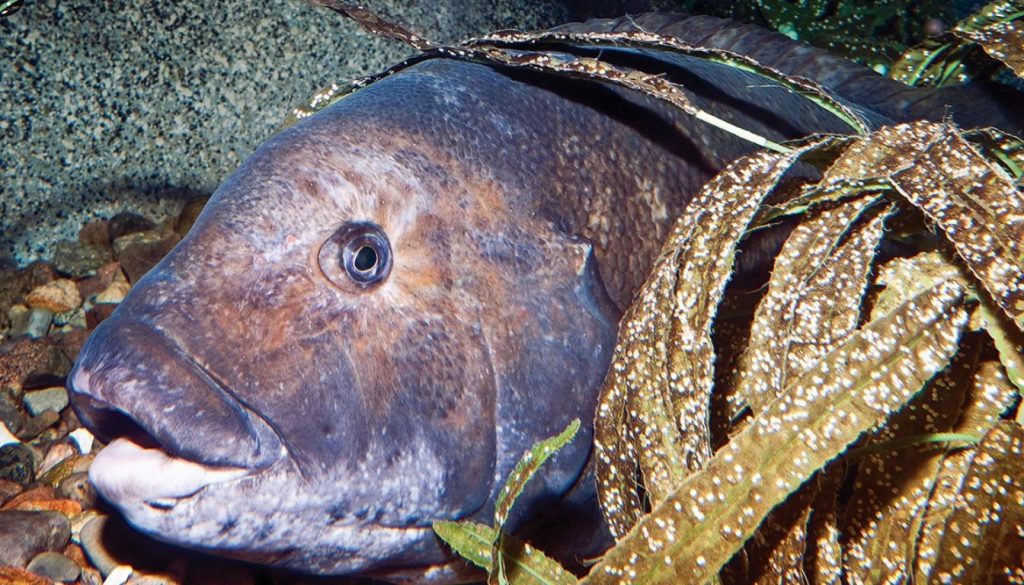
Hotspots: Within their range, tautog tend to concentrate at known structure. For instance, New Jersey reports show excellent tautog action around inlet jetties and rocky shorelines – e.g. the Manasquan Inlet rocks, Sea Bright jetties and the Point Pleasant Canal. New York’s Long Island Sound has tautog around traditional rocky points and piers. South, Chesapeake Bay wrecks and Virginia nearshore reefs are productive. (In all cases, look for steep drop-offs or cover.)
In short, any rocky or reef habitat in a tautog area can hold fish. Local spot reports include Manasquan Inlet and Point Pleasant (NJ), Forked River Inlet (NJ), and offshore wrecks in VA and MD.
Fishing Calendar
Tautog follow a spring–fall cycle. In northern waters they migrate inshore in spring to spawn (usually April–June) and return offshore in winter. A second fall migration brings tautog back onto coastal structure as waters cool (often September–December).
🐟 Tautog Seasonal Fishing Calendar
Understanding blackfish migration patterns for year-round success
SPRING
Apr-Jun
Inshore migration & spawning
✓ Shore accessible
✓ Boat hotspots
✓ Peak nearshore
SUMMER
Jul-Aug
Fish disperse & slow feeding
⚠️ Often closed to harvest
⚠️ Catch-and-release only
Check local regulations
FALL
Sep-Dec
Return to coastal structure
✓ Prime nearshore action
✓ Aggressive feeding
✓ Best for shore anglers
WINTER
Jan-Mar
Deep water offshore fishing
🏆 Trophy potential
🏆 Monster toggs
Requires charters/boats
Spring (Northern Waters): Tautog migrate inshore to spawn, typically April–June. This is prime time for nearshore fishing.
Summer Dispersal: Fish scatter and feeding slows. Many regions close to keepers or allow catch-and-release only.
Fall Return: As waters cool (September–December), tautog return to coastal structure for aggressive feeding.
Winter Offshore: Large tautog remain in deep water. Trophy fishing requires specialized charters.
The current world record was taken in January off Maryland – proving that winter deep-water fishing can yield monster blackfish for dedicated anglers!
✓ Shore & Boat Anglers: Focus on spring (April-June) and autumn (September-December) for best nearshore access and active feeding.
✓ Trophy Hunters: Consider winter deep-water charters (January-March) for potential monster toggs in offshore waters.
⚠️ Always Check: Verify state-specific season dates, bag limits, and size restrictions. Summer closures vary by region.
📍 Target Structure: During migrations, focus on jetties, wrecks, rocky reefs, and bridge pilings where tautog concentrate.
Thus most states allow spring and fall recreational fishing (often with specific season dates and bag limits). During summer, many regions are closed to keepers (or only allow catch-and-release) because tautog disperse or feed slowly.
In winter, large tautog still occur offshore; for example, January charters can land monster toggs (the current world record was taken in January off Maryland). In practical terms: spring and autumn nearshore fishing are best for shore and boat anglers, while winter deep-water togging may reward anglers targeting trophy fish.
Optimal Conditions
Tide: Blackfish bite best when the tide is moving moderately. Anglers find the end of the incoming tide and start of outgoing (high-tide slack) most productive. At slack tide the currents abate, causing tautog to hold just behind rocks to ambush baits. (When the tide is running hard, tautog often bury in holes until the flow eases.)
Time of day: They can bite anytime, but many anglers prefer fishing around dawn or midday when visibility is good. (Some studies suggest little diurnal variation, but consistent high-tide fishing is key.)
Weather: Tautog generally ignore weather. Even rain or cloudy conditions can produce bites – in fact, “rainy weather won’t slow down a hot tog bite.” Cooler water is a trigger – a fall cold front often stirs tautog into feeding. Conversely, once water chills well below ~50°F, tautog will move into deeper water, ending the fall nearshore bite. Overall, plan to fish on the tide rather than worrying about sun or rain – tautog bite in a variety of weather so long as current is favorable.
Gear and Techniques
Recommended Setup
Primary Rod & Reel: Use a stout 7–9 ft medium-heavy to heavy-action rod paired with a quality saltwater spinning or baitcasting reel. Line up 40–50 lb braided main line (thin diameter braid is prized for sensitivity). On the heavy rod match an 8–10 oz casting weight; on a lighter setup use 0.5–2 oz jigs. A high-speed reel with strong drag (20+ lb class) is recommended for quick line pickup and to stop strong runs.
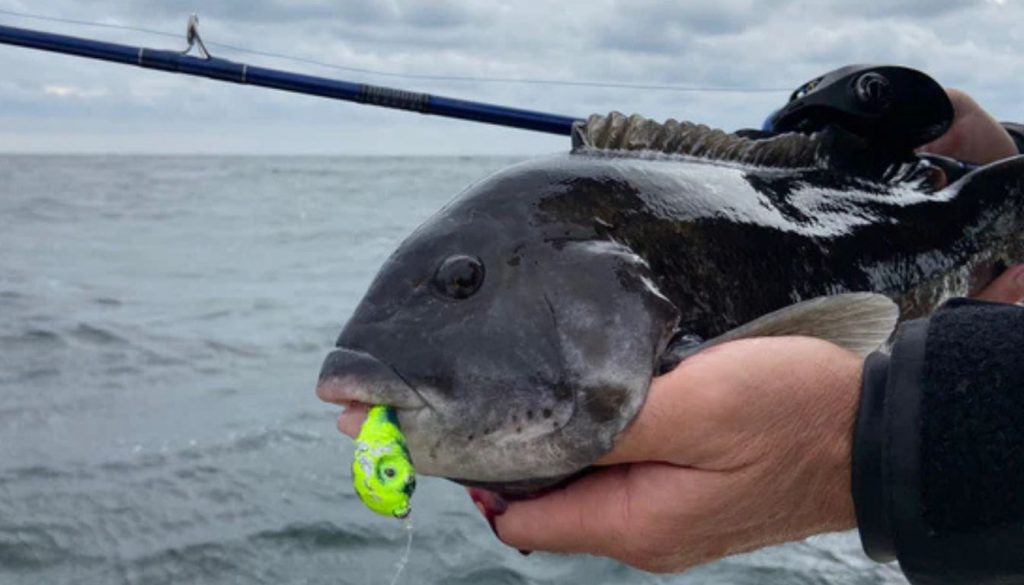
Leader: Tie 3–5 ft of heavy monofilament or fluorocarbon leader (50–60 lb) to the braid. This abrasion-resistant leader prevents cut-offs on sharp rocks. (Keep leaders and rigs fresh – if frayed, retie.)
Alternative Setup: For very large “trophy” tautog or extremely snaggy structure, consider going up to 60–80 lb test braid/leader. Some anglers use two rods: one super-heavy rig for big crabs on a fixed rig, and another lighter rod (30–40 lb) with jig for finesse. Using two rods lets you fish a split-personality approach (heavy rig vs. fluttering jig) simultaneously.
Effective Baits and Lures
Top Natural Baits: Crabs and shellfish dominate tautog baits. Green crabs (common mud crabs) and Asian shore crabs are widely used. Other favorites include blue crabs, fiddler crabs, clams (littlenecks or razor clams) and even wormy mussels. Fish these baits whole or in pieces: for example, green/Asian crabs can be halved or quartered and hooked through the legs (a small serrated hook works well). Sandworms (bloodworms) and small squid strips are also occasionally effective.
Rigging: On a high-low (double-hook) sinker rig, place the bait just above the bottom structure. Many anglers lightly “prep” crab baits by cutting limbs or using small pieces; this gives a continuous scent trail that entices tog once it discovers the bait.
Essential Lures: Tautog jigs (aka “banana jigs” or “rock jigs”) have become very popular. These are lead-head jigs (often with rubber skirts or soft tails) made in ½–4 oz sizes. Use them by tipping the head-hook with a bit of clam or crab, then letting the jig fall to the bottom and “walk” or bounce it along the structure. Bucktail-style jigs and heavy spoons (2–4 oz) also work when retrieved near structure.
Colors: Go for natural, “edible” colors – e.g. green, brown, black or chartreuse. (For example, a green-over-black jig mimics a crab appearance and scent.)
When to Use Them: Live/fresh crabs and clams are go-to in most situations, especially fall. In spring you may also try softer baits (clam or clam strips). Use jigs year-round as a lure tactic: fish them on light tackle, especially early fall. The key is to present bait just above the bottom – either stationary on a rig or on a dead-drift jig – then wait patiently for a pick-up.
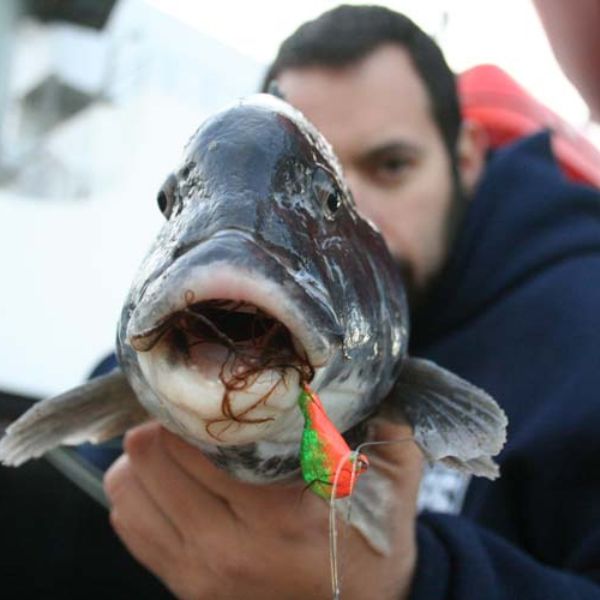
Fishing Techniques
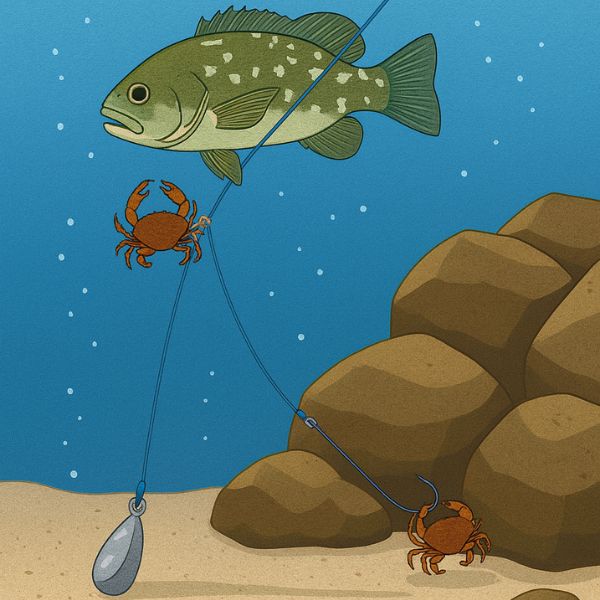
Bottom Rigging (Stationary Bait): Cast or drop your weighted rig with bait onto the rocky bottom near structure. The classic “high–low” rig (sinker below two hooks) is common. Once on bottom, keep tension on the line but allow a little slack for bites. Tautog often nibble gently at first; do not strike immediately on the first twitch. Rather, wait until you feel a distinct pull or pause, then set the hook with a solid sweep. Use minimal hardware (few beads or swivels) to avoid snags.
- Pro tip: Cast past a rock outcropping and let your bait settle on the far side. Fish often ambush from “up-current” sides of rocks, so targeting the calm water behind structure can trigger big bites.
Jigging: Drop a baited jig to the bottom and use a slow lift-drop or “step-jigging” motion to mimic a crab scuttling. Keep the jig just above the bottom cover. The fisherman’s guide suggests using a lighter rod for jigs: let the jig flutter naturally down, then give short twitches every few seconds. Jigs are especially effective in shallower water or when fish are active, as they can provoke strike reactions.
Fight Technique: Once hooked, keep steady pressure and reel aggressively. Tautog will often dive into or run along the rocks; try to turn them and pull them outwards. If a fish drives into structure, raise your rod tip to change angle or hand-over-hand the line to pull it off bottom. Use your drag if needed, but be ready to drive down with low rod tip if the fish tries to dive deep. Heavy braid and a sturdy rod help pull tautog away. As one angler noted, tautog possess “amazing power” – even breaking reel handles – so don’t give them slack.
- Common Mistakes: Hooksetting too early (on the first nibble) is a frequent error. Also, letting them wrap around structure or spooling out can lose fish. Keep the line angled into the rock, and consider pulling sideways rather than straight down to avoid wrap. Using sharp, strong hooks is critical – tautog have tough lips. Finally, because tautog tend to clean hooks if missed, using a double-hook rig on at least one rod can give “two shots” at a bite.
Catch and Handling
During the Fight
When a tautog is on, keep steady pressure and reel without jerking. Since they will dive straight down or side-to-side into cover, maintain a tight line and slowly work the fish away from rocks. If the fish runs into structure, try to bring it out by quickly flipping it with the current (or using your drag as needed).
As noted, even well-equipped reels can fail – tautog have enormous power. If you feel the fish slipping under a ledge, raise the rod tip and possibly point it upward to change the angle. The goal is to prevent the tautog from tangling or wedging itself on the bottom. Keep a finger lightly on the spool if it spits line.
A common beginner mistake is to strip-set too early; wait for the fish to take a firm hold before yanking.
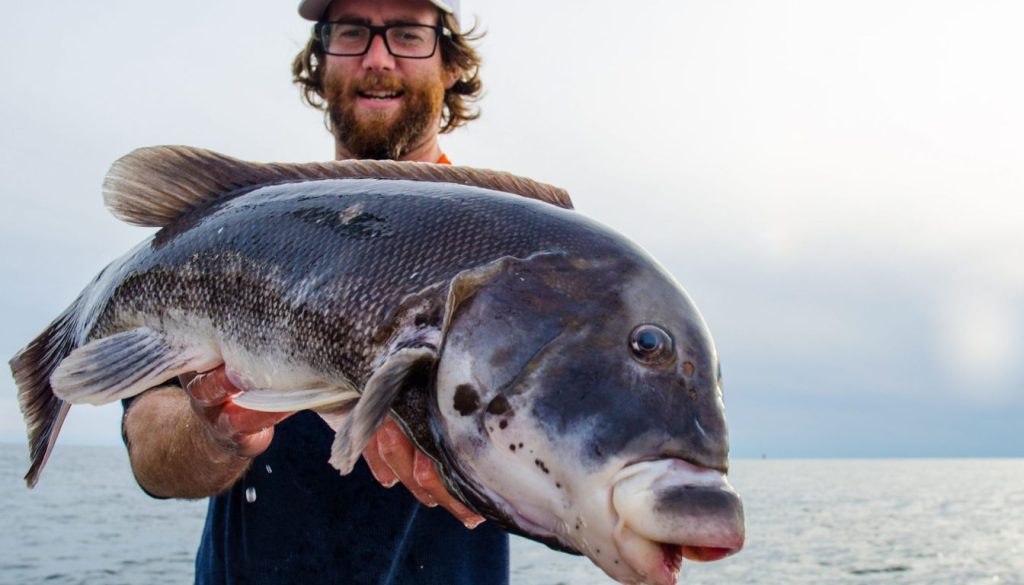
Catch and Release
If you plan to release, minimize handling time. Tautog have tough scales and slime, so wet your hands or use gloves and handle them gently. Use long-nose pliers or a dehooker to quickly remove hooks; cutting the leader and leaving the hook in is acceptable for a safe release. Support larger fish under the belly if lifting them out of water at all.
Research indicates tautog have a low discard mortality (~2–3%) if handled well. To maximize survival, keep the fish upright in the water until it revives (gently move it forward to force water through the gills). Avoid unnecessary blows to the body – go for a quick brain spike if you must dispatch one.
For Consumption
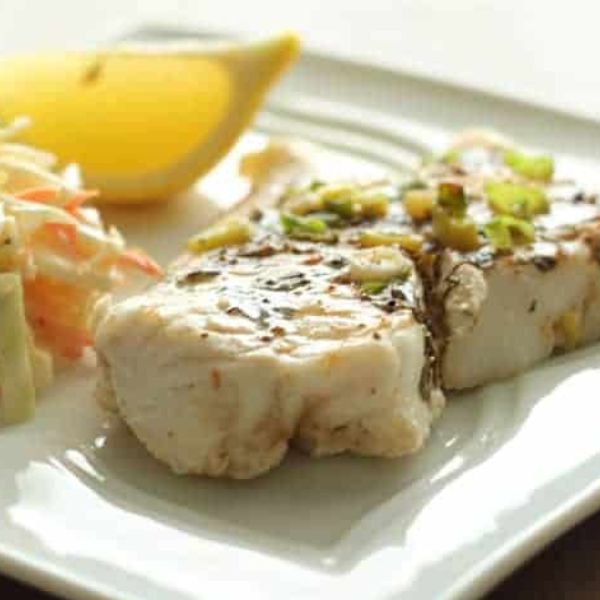
Tautog flesh is excellent eating – white, firm and flavorful. To preserve quality, kill and chill the fish quickly after landing. The preferred dispatch method is a sharp blow or spike to the brain (ike-jime style) to minimize stress and rigor.
Immediately bleeding the fish (cut the gills or tail) and icing it in saltwater slush will keep the meat pristine. Fillet or cook tautog soon – common preparations include baking, grilling or chowder. (One chef notes tautog stews especially well, earning it the nickname “chowder fish.”)
Sources: Contemporary fishing reports and guides
provide the information above. These include current USA regional fishing reports, fisheries commission data, and angler reports. Any statements without a citation were not found in these sources and are generally accepted expert knowledge.
